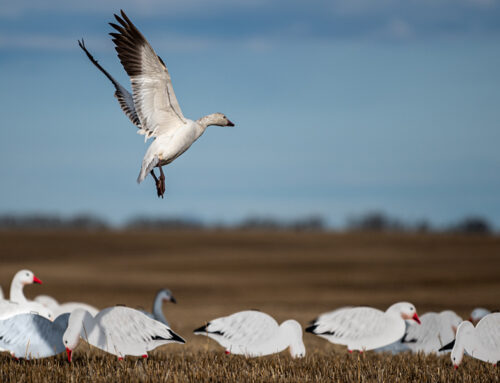Find Ducks in the Late Season

By Kyle Wintersteen
What’s my favorite time to hunt ducks? It’s not the early season, despite its pleasant temperatures, nor even the mid-season, when the migration often peaks. No, give me the bone-chilling days of late December and January, when only the heartiest ducks — and heartiest hunters — are found hitting the remaining waterfowl hideouts.
The remaining mallards are highly concentrated on waning food and open water resources. They’re therefore much easier to find and rather predictable — a cold duck must eat, and a duck that’s eaten must drink.
 Perhaps that’s why many hunters, myself included, tend to kill far more ducks in January than November. Here are a few places you’ll find ducks seeking refuge from the freeze.
Perhaps that’s why many hunters, myself included, tend to kill far more ducks in January than November. Here are a few places you’ll find ducks seeking refuge from the freeze.
Dry Agriculture Fields
Field hunting is a go-to tactic in Canada and many areas of the U.S. prairie pothole region, as ducks and geese stock up on carbohydrates for the long journey ahead. In other parts of the continent, ducks are less frequently found dry feeding. That is, until the late-season chill fosters an urgent need for calories.
Case in point: A cornfield near my mid-Atlantic home won’t see more than a few occasional ducks for much of the season. Yet every January, it’s covered in hundreds of mallards, causing me to ditch my waders for field bibs. The best fields are located near open water, allowing the ducks to make short hops from chow to beverage.
Go with Canada goose decoys for maximum visibility, with a few full-body ducks mixed in. Often Canadas will save energy by dozing in the fields during extreme cold, so sleeper shells can offer realism.
Creeks and Streams
Two seasons ago, a wind chill of -15 led a buddy and me to warm our hands by a small campfire as our decoys bobbed in the creek an hour before sunrise. But as
the smoke cleared on that final day of the season, the ducks emerged: plump drake mallards and a quick limit of black ducks (we could’ve shot many, many black ducks that day).
I look forward all year to hitting ice-lined creek banks winding through the hardwoods, because once the ponds freeze, creeks offer a taste of flooded timber: Ducks darting through the trees and presenting exhilarating, in-your-face shooting.
No need to bother with a huge decoy spread. A dozen or two mallards, with at least a couple on the down-current edge of a riffle to add motion, are plenty.
Smaller streams, particularly if they’re spring-fed to prevent sudden freeze-ups, can also be surprisingly effective. If you find one isolated from additional open water or near food, you’re in the game.
Rivers
Like creeks and streams, rivers tend to heat up as the freeze sets in. My preferred time to hit them is once a few ice floes are present, which tells me nearly all other water will be locked solid. Just be careful: Navigating the floes requires the right equipment and a little common sense — if they’re too large or numerous, it’s not worth the risk.
Ideal places to set up include the down-current edge of an island, point or bend in the river. Thus your decoys are protected from the floes and force of the water, and your spread offers ducks enticing, calm water.
Lakes and Reservoirs
Large lakes and reservoirs typically provide open water well into the season. However, access becomes an issue once plummeting temperatures form a ring of ice around the edge of the lake. If the boat ramp remains open or coated by mere sheet ice — allowing you to access the open water in the center of the lake — you’re in for a great float-blind or layout hunt for divers and other species.
A few pockets of open water often remain, especially near the mouths of creeks down to the tiniest of streams, even as the ice thickens elsewhere. They’re easy to find — just follow the ducks. Locate one relatively near shore with thin surrounding ice, and you’re in business. Slide a johnboat onto the ice, and as it breaks across the bow of your boat, paddle or motor yourself into the open water. If necessary, carefully use your boat to bust ice around the edges of the hole to widen it after the overnight freeze. Then, toss a dozen floating decoys into the hole and line the edge of the ice nearest your blind with full-bodies and sleeper shells. Goose decoys work great for this spread, as they’re visible and ducks will decoy to them as well. This can be a highly effective setup, but it requires extra emphasis on safety. Take at least one hunting buddy, know the limitations of your boat’s construction and always wear your life jacket.
Late-season conditions are hard on equipment, hunters and even the ducks themselves. Yet those who brave them know the rewards justify the shivering.



As an avid duck hunter, a very informative and well written article.